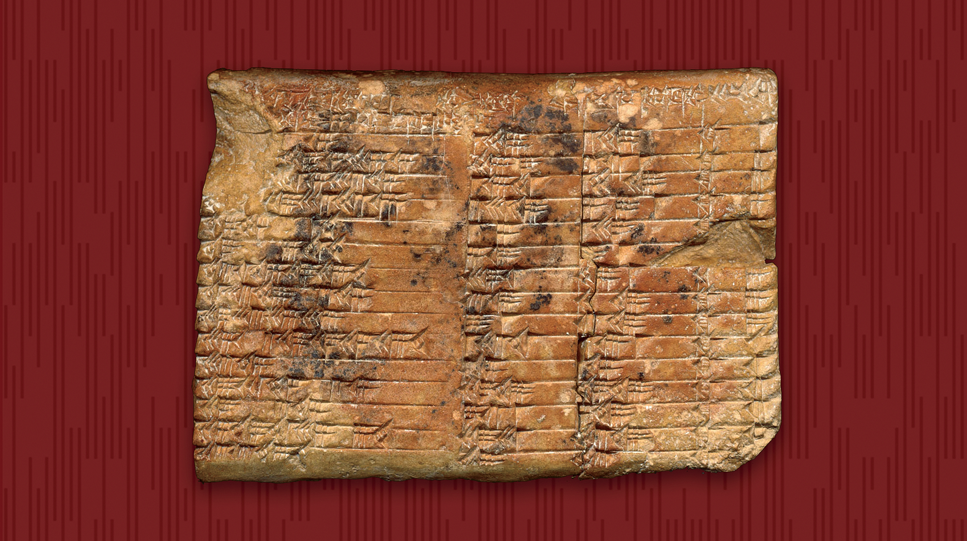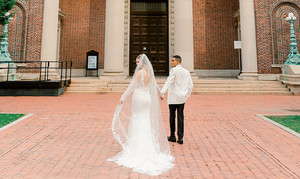The object lies in a deep-blue, velvet-lined box in a display case in the Rare Book and Manuscript Library in Butler. It is five inches wide and three and a half inches tall, sand-colored, and mottled with blotches of rust-orange and black. Fifteen rows of ancient numbers arranged in four columns are notched on the surface, which is marred by a couple of serious gouges.
This 3,700-year-old Babylonian clay cuneiform tablet, known as Plimpton 322, has fascinated scholars for decades. In 1945, the mathematician Otto Neugebauer and the Assyriologist Abraham Sachs announced that the tablet’s sixty inscribed numerals were Pythagorean triples. That is, they satisfy the classic right-triangle equation of a2 + b2 = c2. The tablet therefore suggests knowledge of this essential geometric theorem about one thousand years before the birth of Pythagoras, the Greek philosopher generally credited with the discovery.
Then, this past summer, in the journal Historia Mathematica, Daniel Mansfield and Norman Wildberger of the University of New South Wales in Australia posited that Plimpton 322 is also the world’s oldest working trigonometric table.
“Plimpton 322 describes the shapes of right-angle triangles using a novel kind of trigonometry based on ratios, not angles and circles,” said Mansfield. This would mean that the tablet’s principles predate the work of Hipparchus, regarded as the father of trigonometry, by some 1,500 years.
This startling interpretation of the notched numerals has stirred debate in the math world, inspiring a Scientific American blog post titled “Don’t Fall for Babylonian Trigonometry Hype.” But what is less debatable is how the relic ended up in Morningside Heights.
Columbia has more than six hundred cuneiform tablets in its collection, and George Arthur Plimpton, the grandfather of the author George Plimpton, donated thirty-four of them. A successful publisher, an advocate of higher education for women, and a trustee and the treasurer of Barnard College from 1893 until his death in 1936, Plimpton was an inveterate collector. Assisted by David Eugene Smith, a professor of mathematics at Teachers College, he snapped up wooden cigar-store Indians, Colonial furniture, antebellum slavery documents, and even the bricks of Sir Isaac Newton’s fireplace. He particularly glommed onto old mathematical texts.
Plimpton 322 was uncovered in Iraq at the site of the ancient Sumerian city of Larsa around 1920. After World War I, as the Allies carved up the Ottoman Empire, speculators swarmed to plunder the region’s ancient treasures for museums and libraries. Among these adventurers was Edgar James Banks, an archaeologist who climbed Mount Ararat in search of Noah’s ark and was a model for the fictional character Indiana Jones.
But Banks fell under suspicion of stealing antiquities, according to Laurence Kirby, a professor of mathematics at Baruch College. “He sold ancient tablets to supplement his main livelihood of growing oranges,” Kirby said. In 1923, Banks sold five tablets to Plimpton, including what would become Plimpton 322. Total cost: ten dollars.
In recent years, Plimpton 322 has become a teaching tool and a kind of scholarly destination. Both Kirby and Timothy Halpin-Healy, a physics professor at Barnard, have used it in classroom demonstrations.
Halpin-Healy saves the tablet for the last day of Mathematical Boot Camp for Budding String Theorists, his course in the University’s Summer Immersion Program for high-school students. After pummeling the youngsters with reams of numbers and theory, he escorts them to Butler, where curator Jennifer Lee ’76LS presents some of the texts he has discussed for his charges to see up-close. These include first editions of Galileo’s Sidereus Nuncius (Starry Messenger) and Newton’s Principia Mathematica. Halpin-Healy calls Plimpton 322 the “slam dunk” of the visit.
“It was incredible,” says Maryn Brown, who took the class in 2015 and now studies chemistry at the University of Oxford. “We all whispered excitedly to our classmates, gently pointing out particular figures or parts of the tablet itself. I remember trying to take the perfect photo. After the tablet was taken out of the room, we all sort of stared at each other. I think we were all a bit shocked that we’d just been centimeters away from this mysterious, irreplaceable historical document.”
Halpin-Healy has taught the class for ten years, but he says he has yet to actually touch what he calls “this luscious, earthy, tiny, warm, orangey-red-looking thing” himself. “I’ve never had the courage, I guess.”



